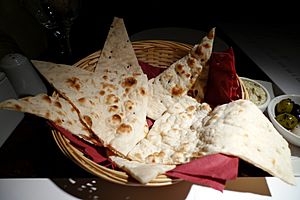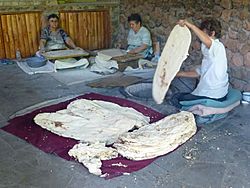Lavash facts for kids
 |
|
| Type | Flatbread |
|---|---|
| Region or state | Western and Central Asia |
| Serving temperature | Hot or cold |
| Lavash, the preparation, meaning and appearance of traditional bread as an expression of culture in Armenia | |
|---|---|
|
UNESCO Intangible Cultural Heritage
|
|

Lavash making in Armenia
|
|
| Country | Armenia |
| Domains | Food |
| Reference | 985 |
| Region | Europe and North America |
| Inscription history | |
| Inscription | 2014 (9th session) |
| Flatbread making and sharing culture: Lavash, Katyrma, Jupka, Yufka | |
|---|---|
|
UNESCO Intangible Cultural Heritage
|
|

Lavash making in Lahıc, Ismailli, Azerbaijan
|
|
| Country | Azerbaijan, Iran, Kazakhstan, Kyrgyzstan and Turkey |
| Domains | Food |
| Reference | 1181 |
| Region | Europe and North America |
| Inscription history | |
| Inscription | 2016 (11th session) |
Lavash is a thin, flat bread. It is usually made with yeast to help it rise. This bread is traditionally baked in a special clay oven called a tandoor (or tonir). Sometimes, it is cooked on a metal griddle called a sajj.
Lavash is very popular in the South Caucasus region, Western Asia, and around the Caspian Sea. It is one of the most common types of bread in countries like Armenia, Azerbaijan, Iran, and Turkey. You can even make lavash at home using a regular griddle or wok instead of a tonir.
In 2014, UNESCO recognized "Lavash, the preparation, meaning and appearance of traditional bread as an expression of culture in Armenia" as an important part of human heritage. Two years later, in 2016, UNESCO also added the tradition of making and sharing flatbreads (including lavash, katyrma, jupka, and yufka) from Azerbaijan, Iran, Kazakhstan, Kyrgyzstan, and Turkey to its list. Lavash is similar to yufka, but in Turkish cuisine, lavaş uses yeast, while yufka usually does not.
Contents
Where Did Lavash Come From?
Many people believe lavash first came from Armenia. For example, The American Heritage Dictionary of the English Language says it is "a thin unleavened flatbread of Armenian origin." Also, when UNESCO added lavash to its heritage list in 2014, it described it as "an expression of Armenian culture."
However, this decision caused some discussion. Countries like Azerbaijan, Iran, Kyrgyzstan, and Kazakhstan felt that lavash was a "regional" food, not just "Armenian." Some experts also suggest that lavash might have started in Iran. Food historian Gil Marks believes it came from the wider Middle East region.
A Brief History of Lavash
The history of lavash goes back to early times. People first cooked thin flatbreads on hot clay griddles. The very first breads were like cakes cooked on hot rocks or in fires. But when griddles became popular, breads had to be made thinner. This helped them cook all the way through without burning. The Bible even mentions a thin bread called rakik. Later, when people invented ovens, they could bake thicker loaves of bread.
What Does "Lavash" Mean?
The word "lavash" has an interesting history. Some language experts connect the Armenian word lavaš to other Armenian words. These words mean things like "palm of the hand" or "flat, polished stone." This makes sense because lavash is a very flat and thin bread. Sometimes, you might see it spelled "Lavosh" in English.
Another expert, Sevan Nişanyan, thinks the word for lavash in both Armenian and Turkish comes from an old Aramaic word. This Aramaic word means "to knead," which is what you do to dough.
How to Make Lavash
Lavash is made from simple ingredients: flour, water, yeast, sugar, and salt. You can also make a version without yeast and sugar, which means it won't rise. Sometimes, people sprinkle sesame seeds or poppy seeds on top before baking.
Traditionally, the dough is rolled very thin. Then, it is quickly slapped onto the hot inner walls of a clay oven. But today, many recipes show how to cook it on a wok or a tava (a flat griddle).
How Lavash is Used
When lavash is fresh, it is soft and flexible. This makes it perfect for wrapping sandwiches. However, lavash dries out quickly and becomes hard and brittle.
In Armenian villages, people stack dried lavash in piles. When they want to eat it later, they sprinkle it with water to make it soft again. Dried lavash is often broken into pieces and used in a dish called khash. Fresh lavash is used to wrap the Armenian barbecue dish khorovats. It is also used to make other wraps with herbs and cheese.
In Iran, Turkey, and some Middle Eastern countries, lavash is used with kebabs to make dürüm wraps, like tantuni. When it's dry, leftover lavash in Iran can be rehydrated with water, butter, or cheese to make quick meals.
In Turkish cuisine, lavaş can also be used for sweet dishes. It is served with traditional Turkish desserts like kaysefe, hasude, pestil kavurması (braised fruit leather), ağuz, and helva. Modern recipes even use lavash like pizza dough.
Traditions and Customs with Lavash
Lavash plays a role in some special traditions. In the Sabirabad District of Azerbaijan, after a wedding, the groom's mother places lavash on the bride's shoulder. She says, "Let you come to the house of wealth, let your foot be lucky." In the Novkhani area, after a funeral, people often prepare kyulchya. This dish sometimes includes halva wrapped in lavash.
Dried lavash can be stored for a long time, sometimes almost a year. The Armenian Apostolic Church uses this long-lasting dried lavash in its Eucharist traditions instead of regular leavened bread.
Lavash in Art
Women baking lavash is a popular subject for Armenian painters. A famous painting by Soviet-era artist Minas Minassian, showing women baking lavash, is displayed at the National Gallery of Armenia in Yerevan.
An American president, Gerald Ford, even chose a print of the painting Armenian Ladies Baking Lavash by Armenian American artist Manuel Tolegian for the White House Bicentennial Collection. If you visit the open-air arts-and-crafts market in downtown Yerevan, you will see many paintings and crafts related to lavash. Pictures of happy women making lavash are a common sight there.
See also
 In Spanish: Lavash para niños
In Spanish: Lavash para niños

